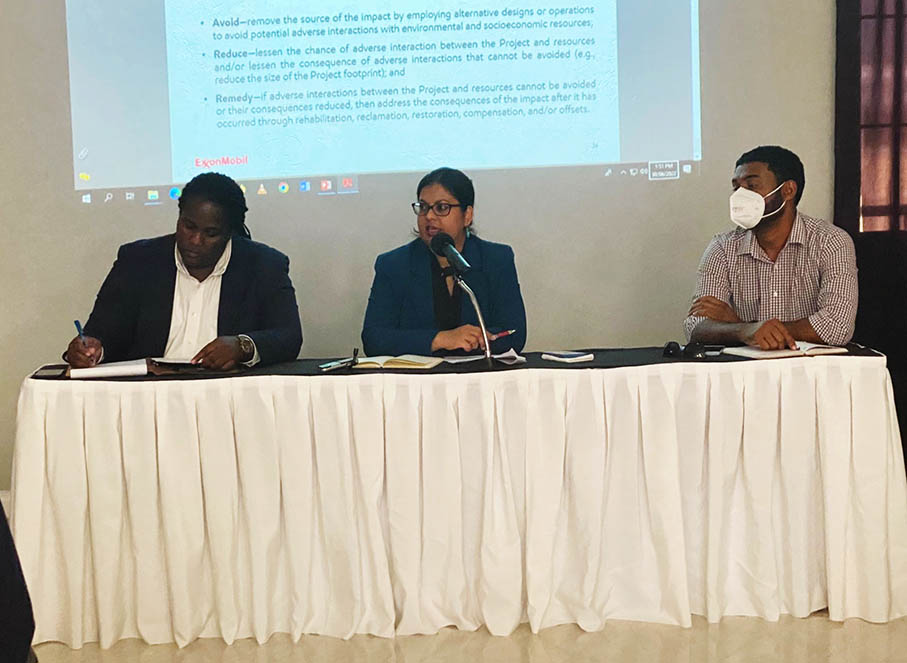Government ministers on Friday told West Demerara residents that the environmental authorisation for proposed ExxonMobil Guyana gas pipeline, which will run from the Stabroek Block to the Wales, West Bank Deme-rara, would be issued within two weeks.
During a meeting with residents whose properties will fall directly in the line of the gas pipeline, Attor-ney General Anil Nandlall was asked whether the government and ExxonMobil are going ahead with the project in the absence of approval from the Environmental Protection Agency (EPA).
His response, based on information relayed by Minister of Natural Resources Vickram Bharrat, caused some concerns. Nandlall told the residents that the EPA will issue its approval of the project within “two weeks’ time”.
Anil Nandlall
“The [approval of the] EIA [Environmental Impact Assessment] will be out in about two weeks’ time. So it would appear that the acquisition [of lands in the path of the pipeline] will follow and I hope that we can conclude immediately and shortly. I do not see them [approval of environmental study and acquisition of lands] as connected,” he said.
Both the EPA and the Environmental Assessment Board (EAB) are supposed to be independent bodies tasked with reviewing the impacts of every project undertaken. The assurance of the authorisation of the project being issued within two weeks would once again raise questions about their independence and government’s involvement in their decision-making.
Over the last two years, environmentalists and activists have been consistently calling out the EPA for its decisions not to require EIAs for a number of large-scale projects and the EAB for upholding those decisions.
The information on when the approval of the gas to shore EIA now brings into question whether Minister Bharrat and by extension, the government, is steering the EAB.
Exxon’s consultant Environmental Resources Management (ERM) submitted its EIA on the gas pipeline project to the EPA on April 13, 2022, triggering a 60-day public review process. There were 11 public disclosure meetings held by ERM to educate the residents on the project.
June 18 was deemed the final day for persons to submit objections and comments on the study to the EPA after which there was back and forth between ERM and the EPA. The final study was then submitted to the EAB.
Ironically, the EAB is comprised of three senior government employees –two of whom are from the Ministry of Natural Resources. The EAB is chaired by Pradeepa Bholanath who is the Senior Director for Cli-mate and REDD+ (Reduc-ing Emissions from Deforestation and forest Degradation) in the Minis-try of Natural Resources, while the other members are Joslyn McKenzie – the Permanent Secretary of the same ministry and government’s Chief Hydrometeo-rological Officer Dr Garvin Cummings.
Stabroek News tried to reach out to Bholanath yesterday but calls went unanswered.
Despite the absence of environmental authorisation for the project, both the government and ExxonMobil have been going ahead with preparations for the project.
On Friday, the government started the process of meeting with persons in the path of the pipeline. They are being offered between one and four million dollars per acre of land. The government said that it has a deadline of October month end to commence the construction of the pipeline.
At the end of July, ExxonMobil announced that it made a contingent award of the contract for the construction of the pipeline.
Subsea 7 and Van Oord consortium announced that it has received a “substantial” contract from ExxonMobil affiliate Esso Exploration and Produc-tion Guyana Limited (EEPGL) for the gas-to-shore project. Subsea 7 said that it considers a “substantial” contract to be in the vicinity of US$150–300 million.
The company said that the scope of the contract covers the project management, engineering, and installation of approximately 190 kilometres of pipeline, with an associated shallow water portion and onshore approach making landfall to the west of the Demerara River, along the coast of Guyana.
The pipeline is expected to be landed at Crane/Nouvelle Flanders, West Coast Demerara and run to Wales on the West Bank of Demerara, where a natural gas liquids (NGL) processing plant and power plant are to be constructed.
The project involves capturing associated gas produced from crude oil production operations on the Liza Phase 1 (Destiny) and Liza Phase 2 (Unity) Floating, Production, Storage, and Offloading (FPSO) vessels.
Some 150 acres of land at Wales have been allocated for the project, which is expected to cut power costs by 50 per cent. The government’s power plant is expected to utilise “dry gas” for electricity generation.
The pipeline project aims to employ approximately 800 workers during the peak construction stage and 40 full-time workers during the operation phase.
It will be executed in three phases – construction, operation and decommissioning. It entails three aspects as well – an offshore pipeline which is approximately 220 kilometres of a subsea pipeline extending from new subsea tie-ins at the Destiny and Unity FPSOs in the Stabroek Block to the proposed shore landing, located approximately 3.5 kilometres west of the mouth of the Demerara River; onshore pipeline that is a continuation of the offshore line and extends about 25 kilometres from the landing site to the NGL plant; and the NGL plant and associated infrastructure that will be located about 23 kilometres upstream from the mouth of the Demerara River on the west bank.
Both the Destiny and Unity FPSOs have pre-installed facilities to allow for the export of the associated gas with crude production.
